
a
To compute: The payoff and the profit for investments when the call option’s exercise price X=$145 assuming that the stock price on the expiration date is $150.
Introduction:
Options: Options are the instruments used in financial transactions. These are derived based on the value of the underlying assets. Normally, the purpose of an option is to provide the buyer an opportunity to buy or sell the underlying asset depending upon the type of contract they possess. There are two types of options- Call option and put option.
a
Answer to Problem 5PS
The call buyer will incur loss of -$0.18 when the exercise price is $145.
Explanation of Solution
The information given to us is as follows:
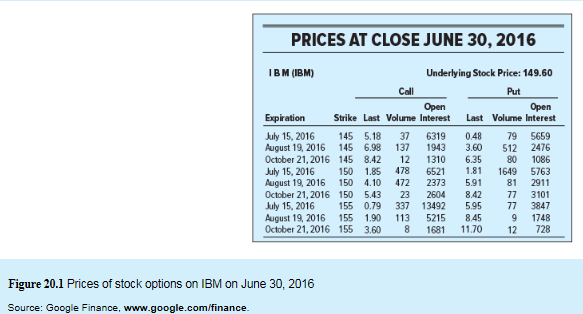
Let us calculate the payoff when Call option X is $145 and stock price on expiry date is $150.
| Calculation of payoff in case of call option | ||
| Position | Stock price > X | Stock price is less than or equal to X |
| Payoff to call holder | Stock price -X | 0 |
| Payoff to call writer | -(Stock price -X) | 0 |
Stock price at expiration is $150.
Exercise or Strike price X=$145.
So, let us now substitute the values in the above table. We get
| Calculation of payoff in case of call option | ||
| Position | Stock price > X | Stock price is less than or equal to X |
| Payoff to call holder |  | 0 |
| Payoff to call writer |  | 0 |
By the above calculation, it is observed that the call writer is prepared to bear the risk in return of option premium as there is loss if stock price increases.
Calculation of profit for investment:

But as per the information given to us, the price of the call option is $5.18 at a strike price $145 on June 2016.

Therefore, the call buyer will incur loss of -$0.18.
b.
To compute: The payoff and the profit for investments when the put option’s exercise price X=$145 assuming that the stock price on the expiration date is $150.
Introduction:
Payoff: In financial terminology, payoff refers to the
b.
Answer to Problem 5PS
The loss incurred by the put buyer will be -$0.48 when the exercise price is $145.
Explanation of Solution
The information given to us is as follows:
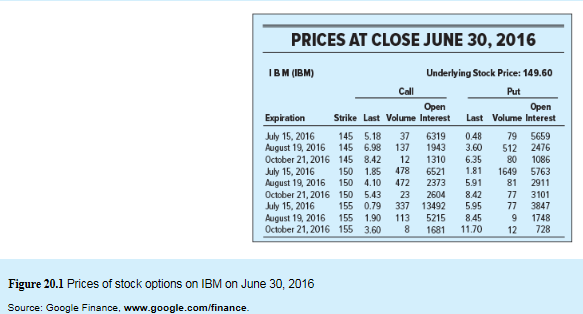
Let us calculate the payoff when Put option X is $145 and stock price on expiry date is $150.
| Calculation of payoff in case of a put option | ||
| Position | If Stock price is less than X | If Stock price is greater or equal to X |
| Payoff to Put holder | X-Stock price | 0 |
| Payoff to Put writer | -(X-Stock price) | 0 |
Stock price at expiration is $150.
Exercise or Strike price X=$145.
So, let us now substitute the values in the above table. We get
| Calculation of payoff in case of a put option | ||
| Position | If Stock price is less than X | If Stock price is greater or equal to X |
| Payoff to Put holder | $0 | 0 |
| Payoff to Put writer | $0 | 0 |

But, we are informed that the put option is $0.48 at a strike price of $145 on June2016.

Therefore, the loss incurred by the buyer on put option will be -$0.48.
c
To compute: The payoff and the profit for investments when the call option’s exercise price X=$150 assuming that the stock price on the expiration date is $150.
Introduction:
Profit on investment: Investments are supposed to be considered as a monetary asset. Investments are done with an expectation to earn good income in future or to sell this asset at a higher price. If the purchase price of the asset is less than the sale price of the asset, it can be termed as profit on investment else it is loss on investment.
c
Answer to Problem 5PS
The call buyer will incur loss of -$1.85 when the exercise price is $150.
Explanation of Solution
The information given to us is as follows:
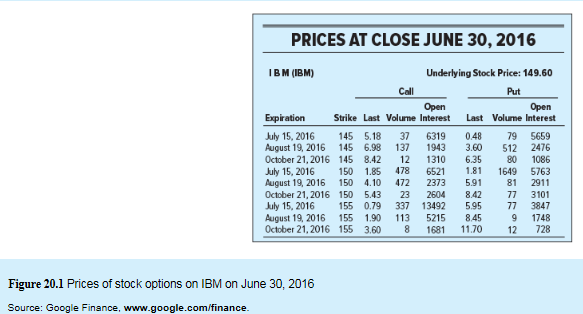
Let us calculate the payoff when Call option X is $150 and stock price on expiry date is $150.
| Calculation of payoff in case of call option: | ||
| Position | Stock price > X | Stock price is less than or equal to X |
| Payoff to call holder | Stock price -X | 0 |
| Payoff to call writer | -(Stock price -X) | 0 |
Stock price at expiration is $150.
Exercise or Strike price X=$150.
So, let us now substitute the values in the above table. We get
| Calculation of payoff in case of call option | ||
| Position | Stock price > X | Stock price is less than or equal to X |
| Payoff to call holder |  | 0 |
| Payoff to call writer |  | 0 |
By the above calculation, it is observed that the call writer is prepared to bear the risk in return of option premium as there is loss if stock price increases.
Calculation of profit for investment:

But as per the information given to us, the price of the call option is $1.85 at a strike price $150 on June 2016.

Therefore, the call buyer will incur loss of -$1.85.
d.
To compute: The payoff and the profit for investments when the put option’s exercise price X=$150 assuming that the stock price on the expiration date is $150.
Introduction:
Options: Options are the instruments used in financial transactions. These are derived based on the value of the underlying assets. Normally, the purpose of an option is to provide the buyer an opportunity to buy or sell the underlying asset depending upon the type of contract they possess. There are two types of options- Call option and put option.
d.
Answer to Problem 5PS
The incurred by the put buyer will be -$1.81 when the exercise price is $150.
Explanation of Solution
The information given to us is as follows:
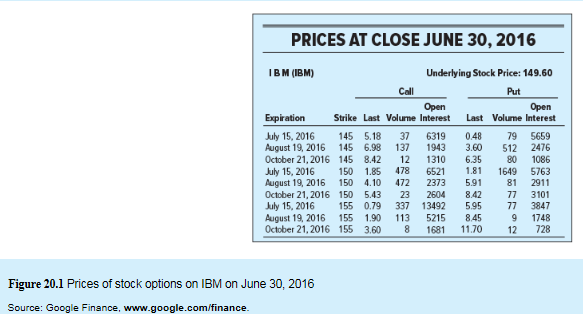
Let us calculate the payoff when Put option X is $150 and stock price on expiry date is $150.
| Calculation of payoff in case of a put option | ||
| Position | If Stock price is less than X | If Stock price is greater or equal to X |
| Payoff to Put holder | X-Stock price | 0 |
| Payoff to Put writer | -(X-Stock price) | 0 |
Stock price at expiration is $150.
Exercise or Strike price X=$150.
So, let us now substitute the values in the above table. We get
| Calculation of payoff in case of a put option | ||
| Position | If Stock price is less than X | If Stock price is greater or equal to X |
| Payoff to Put holder | $0 | 0 |
| Payoff to Put writer | $0 | 0 |

But, we are informed that the put option is $1.81 at a strike price of $150 on June 2016.

Therefore, the loss incurred by the buyer on put option will be -$1.81.
e.
To compute: The payoff and the profit for investments when the call option’s exercise price X=$155 assuming that the stock price on the expiration date is $150.
Introduction:
Payoff: In financial terminology, payoff refers to the return on an investment.
e.
Answer to Problem 5PS
The loss incurred by the call buyer will be -$0.79 when the exercise price is $155.
Explanation of Solution
The information given to us is as follows:
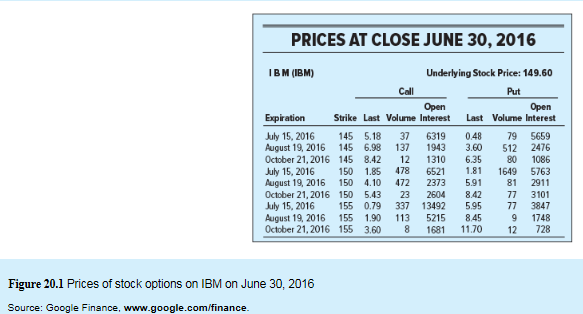
Let us calculate the payoff when Call option X is $155 and stock price on expiry date is $150.
| Calculation of payoff in case of call option | ||
| Position | Stock price > X | Stock price is less than or equal to X |
| Payoff to call holder | Stock price -X | 0 |
| Payoff to call writer | -(Stock price -X) | 0 |
Stock price at expiration is $150.
Exercise or Strike price X=$155.
So, let us now substitute the values in the above table. We get
| Calculation of payoff in case of call option | ||
| Position | Stock price > X | Stock price is less than or equal to X |
| Payoff to call holder | 0 | 0 |
| Payoff to call writer | 0 | 0 |
By the above calculation, it is observed that the call writer is prepared to bear the risk in return of option premium as there is loss if stock price increases.
Calculation of profit for investment

But as per the information given to us, the price of the call option is $0.79 at a strike price $155 on June 2016.

Therefore, the call buyer will incur loss of -$0.79.
f.
To compute: The payoff and the profit for investments when the put option’s exercise price X=$155 assuming that the stock price on the expiration date is $150.
Introduction:
Loss on investment: Investments are supposed to be considered as a monetary asset. Investments are done with an expectation to earn good income in future or to sell this asset at a higher price. If the purchase price of the asset is less than the sale price of the asset, it can be termed as profit on investment else it is loss on investment.
f.
Answer to Problem 5PS
The loss incurred by the put buyer will be $-0.95 when the exercise price is $155.
Explanation of Solution
The information given to us is as follows:
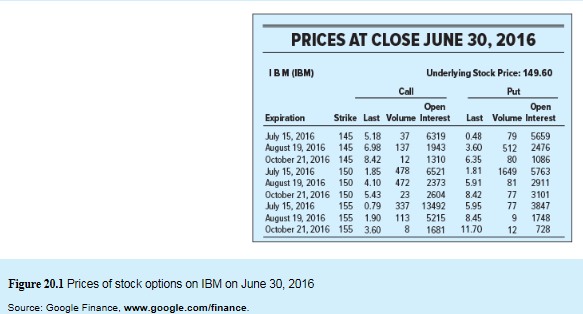
Let us calculate the payoff when Put option X is $155 and stock price on expiry date is $150.
| Calculation of payoff in case of a put option | ||
| Position | If Stock price is less than X | If Stock price is greater or equal to X |
| Payoff to Put holder | X-Stock price | 0 |
| Payoff to Put writer | -(X-Stock price) | 0 |
Stock price at expiration is $150.
Exercise or Strike price X=$155.
So, let us now substitute the values in the above table. We get
| Calculation of payoff in case of a put option | ||
| Position | If Stock price is less than X | If Stock price is greater or equal to X |
| Payoff to Put holder |  | 0 |
| Payoff to Put writer |  | 0 |

But, we are informed that the put option is $5.95 at a strike price of $155 on June 2016.

Therefore, the loss incurred by the buyer on put option will be -0.95.
Want to see more full solutions like this?
Chapter 20 Solutions
INVESTMENTS-CONNECT PLUS ACCESS
- A brief introduction and overview of the company"s (a) uk vodaphone (b) uk Hsbc bank, (c)uk coca-cola history and current position in respective marketplace.arrow_forwardKing’s Park, Trinidad is owned and operated by a private company,Windy Sports Ltd. You work as the Facilities Manager of the Park andthe CEO of the company has asked you to evaluate whether Windy shouldembark on the expansion of the facility given there are plans by theGovernment to host next cricket championship.The project seeks to increase the number of seats by building fournew box seating areas for VIPs and an additional 5,000 seats for thegeneral public. Each box seating area is expected to generate $400,000in incremental annual revenue, while each of the new seats for thegeneral public will generate $2,500 in incremental annual revenue.The incremental expenses associated with the new boxes and seatingwill amount to 60 percent of the revenues. These expenses includehiring additional personnel to handle concessions, ushering, andsecurity. The new construction will cost $15 million and will be fullydepreciated (to a value of zero dollars) on a straight-line basis overthe 5-year…arrow_forwardYou are called in as a financial analyst to appraise the bonds of Ollie’s Walking Stick Stores. The $5,000 par value bonds have a quoted annual interest rate of 8 percent, which is paid semiannually. The yield to maturity on the bonds is 12 percent annual interest. There are 12 years to maturity. a. Compute the price of the bonds based on semiannual analysis. b. With 8 years to maturity, if yield to maturity goes down substantially to 6 percent, what will be the new price of the bonds?arrow_forward
- Lonnie is considering an investment in the Cat Food Industries. The $10,000 par value bonds have a quoted annual interest rate of 12 percent and the interest is paid semiannually. The yield to maturity on the bonds is 14 percent annual interest. There are seven years to maturity. Compute the price of the bonds based on semiannual analysis.arrow_forwardNeed solution this wuarrow_forwardneed assarrow_forward
 Essentials Of InvestmentsFinanceISBN:9781260013924Author:Bodie, Zvi, Kane, Alex, MARCUS, Alan J.Publisher:Mcgraw-hill Education,
Essentials Of InvestmentsFinanceISBN:9781260013924Author:Bodie, Zvi, Kane, Alex, MARCUS, Alan J.Publisher:Mcgraw-hill Education,

 Foundations Of FinanceFinanceISBN:9780134897264Author:KEOWN, Arthur J., Martin, John D., PETTY, J. WilliamPublisher:Pearson,
Foundations Of FinanceFinanceISBN:9780134897264Author:KEOWN, Arthur J., Martin, John D., PETTY, J. WilliamPublisher:Pearson, Fundamentals of Financial Management (MindTap Cou...FinanceISBN:9781337395250Author:Eugene F. Brigham, Joel F. HoustonPublisher:Cengage Learning
Fundamentals of Financial Management (MindTap Cou...FinanceISBN:9781337395250Author:Eugene F. Brigham, Joel F. HoustonPublisher:Cengage Learning Corporate Finance (The Mcgraw-hill/Irwin Series i...FinanceISBN:9780077861759Author:Stephen A. Ross Franco Modigliani Professor of Financial Economics Professor, Randolph W Westerfield Robert R. Dockson Deans Chair in Bus. Admin., Jeffrey Jaffe, Bradford D Jordan ProfessorPublisher:McGraw-Hill Education
Corporate Finance (The Mcgraw-hill/Irwin Series i...FinanceISBN:9780077861759Author:Stephen A. Ross Franco Modigliani Professor of Financial Economics Professor, Randolph W Westerfield Robert R. Dockson Deans Chair in Bus. Admin., Jeffrey Jaffe, Bradford D Jordan ProfessorPublisher:McGraw-Hill Education





